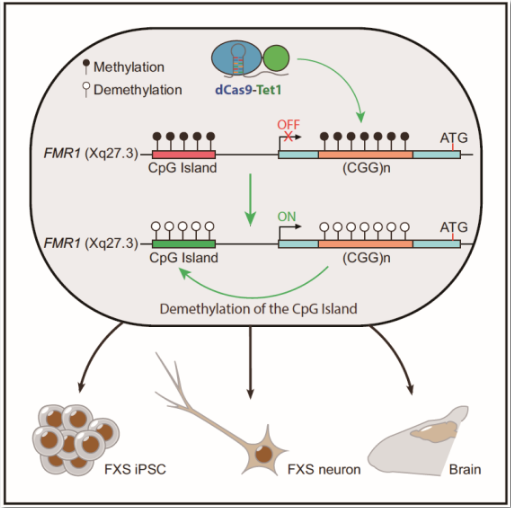Fragile X syndrome is the most common cause of mental disability in men. One out of every 3,600 boys born is affected. This syndrome can also lead to autism, such as social & communication barriers, and attention & hyperactivity problems. At present, this disease can not be cured.
Fragile X syndrome is caused by a mutation of FMR1 gene on the X chromosome. Methylation can block the expression of the mutated gene. It has been confirmed that during the development of the brain, the lack of FMR1-encoded proteins can cause hyperstimulation of neurons associated with the syndrome. Now, in a new study, researchers from the Whitehead Institute of Biomedical Research in the United States used for the first time a developed and modified CRISPR/Cas9 system of which the methylation was removed to restore the activity of the FMR1 gene in neurons affected by the disease. This suggested that the method might prove to be a useful example of a disease targeting abnormal methylation. The results were published online on February 15th, 2018 in the journal Cell, titled “Rescue of Fragile X Syndrome Neurons by DNA Methylation Editing of the FMR1 Gene”. The author was Rudolf Jaenisch, founding member of the Whitehead Institute of Biomedical Research.
Rescue of fragile X syndrome neurons by CRISPR-mediated DNA methylation editing of the FMR1 gene. (X. Shawn Liu, et al. 2018)
This study is the first direct evidence that demethylation removal of a specific segment on FMR1 gene can reactivate the gene, thereby saving neurons affected by fragile X syndrome.
The FMR1 gene sequence consists of a series of trinucleotide CGG repeats, and the length of these repeats determines whether a person suffers from fragile X syndrome: the normal version of the gene contains 5 to 55 CGG repeats; gene version with 56 to 200 CGG repeats is thought to have a higher risk of developing some symptoms of the syndrome; those with more than 200 CGG repeats will produce the syndrome.
So far, the mechanism of that too many CGG repeats in FMR1 are associated with fragile X syndrome is not well understood. But Shawn Liu, a postdoctoral researcher at Jaenisch lab and the lead author of the study, together with others believes that methylation in these nucleotide repeats may play an important role in inhibiting the expression of the gene.
To test this hypothesis, Liu recently developed a CRISPR/Cas9 based technique with Hao Wu, a postdoctoral fellow at the Jaenisch Laboratory, to remove methylation labels from these repeated sequences in FMR1. This technique could add or delete methylation labels of specific DNA fragments. Removing these methylation labels would restore FMR1 gene expression to normal levels. A detailed introduction to the technology was published in journal Cell on September 22nd, 2016, with the title “Editing DNA Methylation in the Mammalian Genome”.
"These results are very surprising. This study almost completely restores the level of the wild-type expression of FMR1 gene. Usually when scientists test therapeutic interventions, they only achieve partial recovery, so the results are significant," Jaenisch said. "
This reactivated FMR1 gene restored neurons produced by inducible pluripotent stem cells (ips cells) affected by fragile X syndrome, thus reversing abnormal electrical activity associated with this syndrome. The activity of the FMR1 gene in these neurons remained at least 3 months when the rescued neurons were transplanted into the brain of the mice, suggesting that the modified methylation may be sustainable in the mice.
"We have confirmed that the disease is reversible at the neuron level," Liu said. "When we remove methylation from the CGG repeats in neurons produced by fragile X syndrome ips cells, we achieve full activation of the FMR1 gene."
The CRISPR/Cas9 based technique may also be used to treat other diseases caused by abnormal methylation, including facioscapulohumeral muscular dystrophy and imprinting.
"This research has demonstrated this approach of targeted gene methylation, and it will serve as an example for scientists to treat other diseases in this way," Jaenisch said.
References:
X. Shawn Liu, Hao Wu, Marine Krzisch, et al. Rescue of Fragile X Syndrome Neurons by DNA Methylation Editing of the FMR1 Gene. Cell, Published online: February 15, 2018.
Liu X S, Wu H, Ji X, et al. Editing DNA Methylation in the Mammalian Genome. Cell, 2016, 167(1):233.


